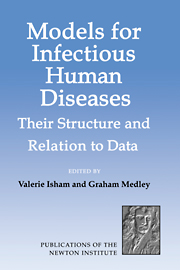Book contents
- Frontmatter
- Contents
- Introduction
- Participants
- Non-Participant Contributors
- Part 1 Transmissible diseases with long development times and vaccination strategies
- Part 2 Dynamics of immunity (development of disease within individuals)
- Part 3 Population heterogeneity (mixing)
- Part 4 Consequences of treatment interventions
- Part 5 Prediction
- AIDS: modelling and predicting
- Staged Markov models based on CD4+ T-lymphocytes for the natural history of HIV infection
- Invited Discussion
- Short term projections by dynamic modelling in large populations: a case study in France and The Netherlands
- Bayesian prediction of AIDS cases and CD200 cases in Scotland
- Some scenario analyses for the HIV epidemic in Italy
- Relating a transmission model of AIDS spread to data: some international comparisons
- Estimation of the rate of HIV diagnosis in HIV-infected individuals
- Effects of AIDS public education on HIV infections among gay men
- Changes in sexual behaviour and HIV control
- The time to AIDS in a cohort of homosexual men
Relating a transmission model of AIDS spread to data: some international comparisons
Published online by Cambridge University Press: 04 August 2010
- Frontmatter
- Contents
- Introduction
- Participants
- Non-Participant Contributors
- Part 1 Transmissible diseases with long development times and vaccination strategies
- Part 2 Dynamics of immunity (development of disease within individuals)
- Part 3 Population heterogeneity (mixing)
- Part 4 Consequences of treatment interventions
- Part 5 Prediction
- AIDS: modelling and predicting
- Staged Markov models based on CD4+ T-lymphocytes for the natural history of HIV infection
- Invited Discussion
- Short term projections by dynamic modelling in large populations: a case study in France and The Netherlands
- Bayesian prediction of AIDS cases and CD200 cases in Scotland
- Some scenario analyses for the HIV epidemic in Italy
- Relating a transmission model of AIDS spread to data: some international comparisons
- Estimation of the rate of HIV diagnosis in HIV-infected individuals
- Effects of AIDS public education on HIV infections among gay men
- Changes in sexual behaviour and HIV control
- The time to AIDS in a cohort of homosexual men
Summary
Introduction
The first phase in researching AIDS epidemiology using transmission models was characterised by a need to promote understanding of the dynamics of the epidemic and provide a template around which to specify data collection needs. Unlike the back-calculation and curve fitting approaches, there was no need to directly relate model output to data: comparisons between different model runs offered insight and understanding. Transmission models became more complex with the incorporation of heterogeneity in sexual behaviour, variable infectiousness and various forms of mixing between partners.
Transmission modelling has more to offer than a capability to make projections of the likely course of the epidemic. For instance, it is incontrovertibly the best way to assess the effects of various interventions which may help in mitigating the extent of the epidemic. However, the inherent complexity involved in formulating a transmission model which embraces all three main groups of susceptibles (homosexuals, intravenous drug users and heterosexuals) has meant that, in the main, transmission models have been restricted to the homosexual risk group. By one criterion this is appropriate for in the United Kingdom, United States and several countries in Western Europe, the homosexual population has contributed the largest proportion of the cumulative total of AIDS cases thus far reported. Where exceptions to the single risk-group transmission models exist, they are far from parsimonious in the number of independently specified parameters. The scope for relating models containing scores of parameters to time-series data is extremely limited.
It is the relating of a model to time-series data on reported AIDS cases which marks the second phase of epidemiological research using transmission models.
- Type
- Chapter
- Information
- Models for Infectious Human DiseasesTheir Structure and Relation to Data, pp. 473 - 476Publisher: Cambridge University PressPrint publication year: 1996
- 16
- Cited by

